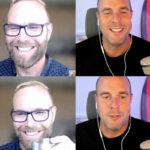James: James Schramko here from SuperFastBusiness. I’m here with my friend, Kory Basaraba, from Grow Fast Marketing. Hey, Kory.
Kory: James, how are you?
James: Good. Kory, you’re an expert in driving paid traffic, having high-converting funnels, and also looking at the data to be able to supercharge that entire ecosystem. I know you’re good at all those parts, which makes you a bit of a freak, in a good way. But I’d love to talk about the difference between customer avatar and the customer journey because I think these names get banded around in marketing discussions. We’re not talking about the movie with the blue person in it. I think he’s blue, right, in Avatar? We’re talking about the customer avatar as described by, I think, Eben Pagan and maybe a few other marketers have talked about, where you define a customer.
And then there’s the journey. And that’s also been talked about as funnels. I don’t I love that name. But I guess it’s the part from where someone is a suspect or a prospect, depending on which marketing school you go to, right through to when they’re placing multiple orders. So can you speak to the differences between the two and how you incorporate those into your three-part system of growing businesses rapidly?
Kory: Sure, well, it’s interesting, because there’s a lot of focus on the avatar. And it’s good to understand who are you talking to, what’s their desires and wants. And the thing with an avatar is it’s a static snapshot of where someone is right now. And what I found to be a lot more effective is to map out the journey of where do they want to be, right? We’re all in the process of becoming someone different, even if we’re just trying to solve a problem, right?
A person who’s got a successful Facebook campaign is different than the person who is desiring a successful Facebook campaign. And so when I look at a funnel, I look at what someone’s trying to accomplish. The job is to map out, okay, where’s your prospect now? And what are all the steps along the way that they have to take to get their desire, right? And when you think of a journey, there’s always roadblocks and ups and downs, and pits and traps that people are going to encounter along the way. And when you’re the first person to identify those, it allows you to create a lot of empathy in your marketing. If you’ve just hiked, you know, hundred miles through India, and seen all these little villages, and someone else has also hiked through India, you’re going to be able to have a whole different conversation than someone who’s never left their apartment in New York, right?
So I just found it really helpful to overlay the journey onto your planning, when you’re looking at your traffic, your funnel, your conversion, and make that connection, it just gives you a lot of rich material to work from.
James: That’s really deep, actually, because you’re right: a customer avatar is just one-dimensional, that snapshot as you talked about. Whereas you’re more or less in the transformation business. If you’re selling something, you want to help people see they’ll be better off and help them move forward with that. Beyond that, it’s ideal if you can continue to help them be better off, you know, later on. That first sale is not the end, it’s actually the start really, of the good stuff, where you can make extra sales or recurring sales, upsells, cross-sells, reactivate. So when people talk about different stages of the funnel,
I think there’s like people who aren’t aware of your product, or service, people who are aware of your product or service, but not quite in that buying zone. And then there are people who are fully aware of your product or service, and they’re ready to buy right now. They would also be different snapshots of different avatars. So how does a marketer plan to take into account the varying stages of an avatar and the various awareness that they have, and various parts of the journey? It’s now starting to feel quite complicated.
Kory: Yeah, it can be. And that’s why it’s important to take a moment and map it out into a picture that you can look at. Then everyone on your team can get on the same page and say, This is the journey. And when you’re looking at that start to finish, one of the things that I stress is your funnel, and you said it, your funnel starts from first contact, right? The first ad all the way through their journey of their first purchase, and then onwards.
So if you’re trying to figure out, how do I acquire customers using Facebook or Google ads, you want to map out that first part of the journey, right? And so one of the things that’s helpful is to ask yourself, what must your customer believe in order to purchase and someone who’s farther out there at the start of their journey, they’re not even really sure, they’re just vaguely aware they know they’ve got a problem. They’re going need to believe a few different things. And the person who is already familiar with you, and has a certain level of trust, maybe they’ve seen your videos, they trust your brand.
And now you come out with an offer, they already believe in you. So they just have to believe in the offer. Whereas the person who’s farther away, they have to believe in you. So you would just build your messaging to help them take every step. We know that no one’s going to buy anything unless they have all their questions answered, right? And so it’s about just figuring out what are the questions you need to answer along the way.
James: Gotcha. So this really helps you make choices around things like, in my case, I have a book on Amazon, and I have lots and lots of podcasts, like, lots and a stack of videos. These are all awareness tools that help people get to know me and understand more about the problems I solve before they enter my website.
And it seems once they enter the website, then we’re into that next part of the journey, versus someone who doesn’t have that front end, warming up, I guess. They’re going to have to have a different approach on the website, if that’s the first protocol. If they’re driving an ad from a platform straight to their webpage, I imagine they will have to have completely different considerations.
Kory: Hundred percent. And that’s one of the challenges when you start, you know, looking at other people’s funnels and trying to duplicate it or emulate it. Their funnel might be based on a whole different customer journey than yours. And if you try to do the same thing, it’s not going to work. Right?
So yeah, people who are already getting to know you through your content, when they get on your page, you don’t need a long sales video or a long sales page necessarily, right? They’ve already done a lot of the heavy lifting. Whereas if someone is coming in from a Facebook ad, and they’ve just seen your ad, and now they’re on your page, you have to tell a very compelling story. It’s just like someone walking into your dealership off the street cold, right?
Some of them are ready to buy now. It’s a quick conversation. Others, you’re going to spend an hour, two hours, three hours with that person. And if all you did was say, we’re only going to sell to people who are ready to buy now, you’d be leaving so much money on the table. So the trick here is figuring out where do you have that long conversation. Do you have it over multiple videos? Or do you have the long conversation on the landing page, right? But somewhere that conversation has to happen. And so this gives you a way to slice and dice and look at your funnel and say what does my customer need to get across the finish line?
James: That’s very powerful. And you know what I also discovered, sometimes the people who are ready to buy right now, are not as good as a customer as someone who you get to incubate and warm up your way over time, because the person who’s ready to buy right now, quite often have taken other things for granted or been exposed to other elements that make it a little bit harder to compete in the marketplace or to show your unique position.
So I’m interested, as a marketer, how do I get to understand more about the customer journey? Because when I look at my ecosystem, there’s a lot of data, and it’s pretty confusing, you know? I’ve got tools that I can look at as a dashboard. And it’s showing me that I’m making sales from social media videos, I’m making sales from my emails and making sales from some paid campaigns. But you can’t really just go off one platform’s pixel, right, because there’s going to be inaccuracies and it doesn’t really see the whole picture?
Kory: Yeah, well, you’re opening a couple of really good doors there, James.
James: Maybe we’ll cover those on some other training topics. But there are ways to do it. I guess it’s really the thing I wanted to know?
Kory: Right? Yeah, there are way to do it. Absolutely. And depending on where you’re at, if you’re starting out, or you’re launching a new offer, one of the first things I have people do is just interview and talk to 10 of your best customers. And you ask them one of the key questions is what was on your mind before you bought? What was happening in your life? And what made you even start thinking about this?
And it’s interesting, when they start answer that you say, just go back in time, and you kind of guide them a little, a little guided visualization and what is happening in your life? And the stuff they say there you can count on. Okay, your best customers are feeling and experiencing this before they found you. So you can start to put some flags in the ground. Okay, this is probably a good start on mapping out our customer journey.
And then there’s the whole data piece, like you said, which requires a little more thought and care. But at a certain stage in your business, it’s essential. You can get pretty far to business with some sloppy data, right?
James: Yeah, I did. I went for a long time without knowing exactly where they were coming from. And I just knew I was doing a lot of podcasts and publishing a lot of content. And because I didn’t do launches, and because I didn’t have affiliates for so long, and we’re getting good SEO, it just gave me a good, general sense of it.
And every time I go to a local meetup, or a live event, pretty much everyone I meet says, Oh, I heard you on the podcast first. And then I came like, I know that was a very strong pathway. But when I got more granular, and especially when I started making little videos like this one we published today, I’ve discovered that there is a massive amount of traction to be gained from short content videos, because people are time-poor, they’re overloaded, they don’t want to get into a really deep course, it’s going to take them the next three months, but in reality they probably will never open once. It would be good if they could just learn something.
I’ve already learned some things on this particular training. And that is the difference between an avatar and the journey, and how you have to consider where they’re at in the journey. Just one final question, Kory. Are you able to look at funnels, ads and the backend data and get a sense of if someone’s on track or not fairly quickly?
Kory: Yeah, absolutely. Because when you look at the actual story that the data is telling you, you can’t hide anything, right? So if we start saying how many people are clicking your ads, how many people are visiting your landing pages? How many buyers do we have? That tells a story and either it’s the story you want to hear or there’s an opportunity to improve it. And it’s about identifying where is it in that sequence that you need to put your attention, right?
And so first thing is, what’s happening now and then understanding what’s stopping us from growing and then putting your attention on that area. A lot of people are fiddling with their Facebook ads when the problem is actually in their funnel.
James: Or the font on their website.
Kory: That’s exactly right.
James: I did that when I started, I was focused on the wrong things and people like you then set it straight,
Kory, I appreciate it.
Kory: My pleasure. Happy to be here.
James: If you want Kory to have a look at your own ads and funnel and back-end data, he can probably help you out. Get over to GrowFastMarketing.com. Check out Kory Basaraba, thank you so much. I appreciate the tips.
Kory: Thanks, James.
Get help with your ads, funnels and back-end data from Grow Fast Marketing
See our products HERE









Leave a Reply